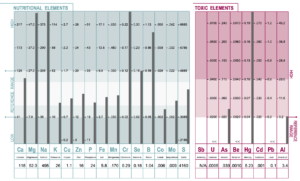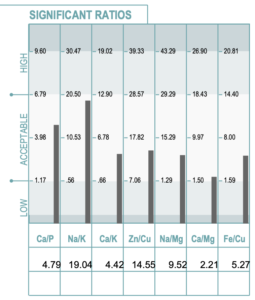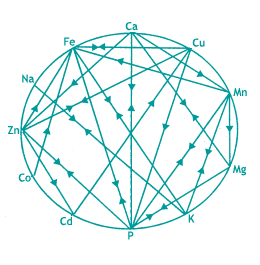A blueprint for nutrition, performance and optimum wellness
What is HTMA?

Hair tissue mineral analysis (HTMA) is a non-invasive test that measures the levels of nutrients and toxic metals found in the hair. It can detect an excess or deficiency of nutrient minerals such as calcium, magnesium, potassium and zinc. It can also identify over exposure to toxic metals such as arsenic, aluminium, cadmium and lead. It is regarded by many integrative doctors, naturopaths, nutritional therapists and vets as one of the most valuable screening tools available in everyday and preventative health care.
Hair is a body tissue made up of mostly dead, keratinized cells fused together. The shaft of the hair is the portion that projects from the skin’s surface. The root of the hair, below the skin’s surface, contains living matrix cells from which the hair grows. Matrix cells depend on the blood supply for nourishment and growth. As they grow and divide, minerals are keratinized into the growing hair shaft, creating a permanent record of metabolic activity and exposure to toxic elements. Research has shown that hair tissue is useful in indicating nutrient imbalances and exposure to toxic elements.
Hair Tissue Mineral Analysis provides valuable information on existing health conditions. For example, minerals status can provide you with insight into the production of hormones, enzyme activity, energy production, digestive health, stress levels and much more. Further, it helps with early detection and prevention of conditions, as mineral imbalances are often seen before symptoms occur.
Why get a HTMA for my dog?
Minerals are essential for growth, healing, vitality and wellbeing. They provide structural support in bones and teeth, and maintain the body’s pH, water balance, nerve activity, muscle contractions, energy production and enzyme reactions. They are the basic ‘spark plugs’ of life.

The right amount of minerals in the right ratio is the key to optimal animal health. Biochemical, emotional and physical stressors can deplete the body of essential nutrients. Environmental toxicity and chronic health issues may result in the accumulation of toxins in tissues and disrupt normal body chemistry. Using HTMA as a screening test can provide considerable information about the health of your dog, and can help prevent serious health issues by early detection. The comprehensive results give an indicator of the long term effects of diet, stress and toxic metal exposure.
Examples of mineral imbalances in animals include a rough coat, flaky skin, poor growth, eating dirt, de-barking trees, tooth decay and worse. Mineral deficiencies, as well as excesses, can lead to ill health and disease.
What does it test for?
The test provides reliable clinical data on 32 nutrient and toxic minerals, 27 significant mineral ratios and a comprehensive report.
Nutritional minerals
Boron, Calcium, Chromium, Cobalt, Copper, Iron, Magnesium, Manganese, Molybdenum, Phosphorus, Potassium, Selenium, Sodium, Sulphur, Zinc
Toxic minerals
Aluminium, Arsenic, Beryllium, Cadmium, Lead, Mercury, Uranium
Additional minerals
Barium, Germanium, Lithium, Nickel, Platinum, Strontium, Tin, Tungsten, Vanadium, Zirconium
The Hair Tissue Mineral Analysis Report
Nutritional Minerals and Toxic Elements

Nutritional mineral ratios can reveal a great deal about an animals nature and performance. A deficiency of essential nutrients may also identify the cause of ill health. For example, calcium and magnesium are required in proper balance for normal muscle contraction and relaxation. An imbalance in the ratio of calcium relative to magnesium can indicate muscle tone and strength, and nervous system function. Sodium levels may indicate how an animal utilises protein. An imbalance may cause fatigue, a rough coat and a decreased rate of growth.
Mineral deficiencies, excesses, and/or biochemical imbalances can be indicative of a tendency toward an adverse health condition. This invaluable, personalised report provides an in depth analysis of mineral imbalances and an explanation of how these imbalances may have an impact on the health of each animal.
All humans and animals are exposed to toxic metals to some degree. Sources of exposure can include pollution, drinking water, feed and pharmaceutical medicines. The retention of these toxic metals is dependent upon the animal’s susceptibility. The balance of protective nutrient minerals in the body in relation to the heavy metals can be the determining factor in this susceptibility. This report reveals the toxic metal levels in relation to the protective minerals and explains the extent to which these heavy metals are involved in the abnormal chemistry.
Ratios

The ratios are a calculated comparison of two minerals to each other, this is called a ratio. To calculate a ratio value, the first mineral level is divided by the second mineral level.
SIGNIFICANT RATIOS
If the synergistic relationship (or ratio) between certain minerals is disturbed, studies show that normal biological functions and metabolic activity can be adversely affected. Even at extremely low concentrations, the synergistic and/or antagonistic relationships between minerals still exist, which can indirectly affect metabolism.
TOXIC RATIOS
It is important to note that animals with elevated toxic levels may not always exhibit clinical symptoms associated with those particular toxic minerals. However, research has shown that toxic minerals can also produce an antagonistic effect on various essential minerals eventually leading to disturbances in their metabolic utilisation.
Endocrine Function and metabolic rate
Neuro-endocrine activity affects mineral absorption, retention and excretion; therefore, tissue mineral patterns reveal certain biochemical characteristics, which are termed metabolic types. Based on mineral patterns determined by the hair, thyroid and adrenal gland activity can indicate if the animal has a fast or slow metabolic rate. These endocrine glands influence energy production on a cellular level and ultimately the health and performance of the animal. A major deviation between the pituitary-adrenal-thyroid axis can be indicative of a tendency or trend toward an adverse health condition,

Generally speaking an animal with a fast metabolic rate is high spirited and suited to athletic performance. However, when minerals are out of balance the metabolic rate can become excessive and may be rapidly dissipated due to a nervous or high-strung nature. On the other hand an animal with a slow metabolic type there is a tendency toward low thyroid activity. Since the thyroid is responsible for energy production and release on a cellular level, this may indicate an inability for the animal to sustain performance resulting in low endurance.

Why not use blood instead?
- Hair testing is non-invasive and easy
- Cutting your pet’s hair is painless
- No special handling of the sample so it can be mailed in an standard mail envelope
- Cost-effective
- Blood is a snapshot
Blood shows a snapshot of what is happening in the dog right now. While this is important information, it doesn’t supply an accurate analysis of the mineral levels over a period of time. The blood will “borrow” nutrients from cells and tissues to create homeostasis in the blood.
For example, a dog’s cells and tissues might be losing essential minerals such as sodium and potassium while the blood reveals what appears to be normal levels of these two minerals. However, a dog might show signs and symptoms of low potassium and sodium deficiency, but the blood results are normal. Blood results can be a late indicator of a problem.
“The balances between these essential nutrient minerals are more easily disrupted in the cells and tissues than they are in the blood. Deficiencies and excesses of minerals are more readily observed in an HTMA than in a blood analysis or urinalysis. Therefore, an HTMA is often an earlier indicator of a trend towards health problems (physical and psychological) than is a blood analysis or urinalysis. This fact is very important, especially when considering disease prevention or health maintenance nutritional supplement program.” – Dr. Rick Malter, Ph.D. The Strands of Health, 2003.
Instructions

STEP 1
Go to the SHOP page and make payment.
You have two options for payment:
1 – The test results and report. You will be sent a full copy of the results and accompanying report from the laboratory.
2 – The test results and report in combination with a consultation with me to discuss the results in more depth. Note: consultations can be conducted online or in person, depending on where you are located.
STEP 2
Once payment has been made, I will post you a test kit and laboratory request form for you to complete. This includes a small envelope for the hair sample. Follow the instructions for how to take the hair sample from your dog.
STEP 3
Once you have collected the hair sample, post the sample and request form directly to the laboratory (address details are in the test kit you will receive)
Allow approximately 2 weeks for results to be received.
Once the results are received, you will be sent a full copy of the report.

How To Take a Hair Sample
To take the hair sample, ensure that the hair has been washed thoroughly, untreated, rinsed completely and dried. Cut the hair close to the skin, in a few small portions, and from several areas on the back of the neck. Cut hair as close to the skin as possible. Scissors should be high grade stainless steel or plastic to avoid contamination. The length should not be more than 5-6cm, retain the proximal (root) portion and discard the rest. This part reflects the most recent metabolic activity. The amount of hair necessary for analysis is half a gram, or approximately one tablespoon of hair, which should be placed in the sample collection envelope provided.
Why Practitioners use Hair Tissue Mineral Analysis
- Identify heavy metals and toxic element burdens and access progress.
- Identify nutritional deficiencies, excesses and imbalances then develop a precise nutritional therapeutic approach
- Ability to monitor health and nutritional balances over time – retest, review and revise the plan.
- Recognition of the sympathetic and parasympathetic responses to metabolic dysfunctions.
- Determining the link between the nutritional, neurological and endocrine systems, as identified by hair mineral patterns.
- Development of a supplement program for specific bio-individual and metabolic types.
- Identification of endocrine interrelationships and their impact upon biochemical and nutritional status; recognition of specific nutritional influences upon the biochemical and endocrine systems.
- Real measurements of nutrient and toxic minerals in parts per million.